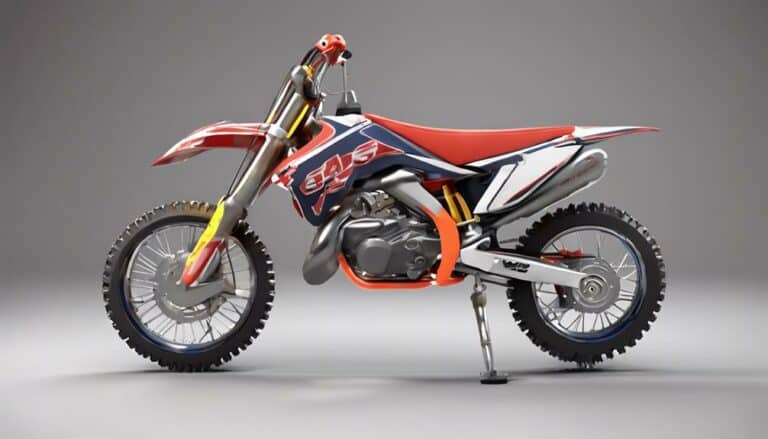When it comes to motocross dirt bikes, the debate between 4-stroke and 2-stroke engines continues to spark interest among riders.
You may find yourself torn between the raw power of a 4-stroke engine and the nimbleness of a 2-stroke option.
Each has its own set of advantages and disadvantages that can greatly impact your riding experience.
So, which engine type will emerge victorious in your quest for motocross glory?
Key Takeaways
- 4-stroke engines offer smoother power delivery and consistent performance for enhanced track stability.
- 2-stroke engines excel in lightweight design, nimble handling, and raw power, but emit more and require more maintenance.
- Choosing between engine types depends on skill level, riding style, maintenance needs, and budget constraints.
- Balancing advantages like power, weight, emissions, and maintenance helps in selecting the right engine type for motocross dirt bikes.
Benefits of 4-Stroke Engines
4-Stroke engines in motocross dirt bikes provide riders with a smoother power delivery, enhancing stability on the track. This feature is important for controlling your bike effectively, especially when maneuvering through different terrains. The predictable power output of 4-stroke engines aligns with various riding styles, allowing you to adapt seamlessly to the track's demands. The smooth power delivery not only makes the bike easier to ride but also guarantees a consistent performance throughout your ride.
Additionally, the maintenance aspect of 4-stroke engines contributes to their appeal. Requiring less maintenance than their 2-stroke counterparts, these engines grant you more time on the track and less time in the garage. This advantage not only saves you effort but also enhances your overall riding experience by minimizing downtime. Ultimately, the combination of smooth power delivery, adaptability to different riding styles, and reduced maintenance makes 4-stroke engines a preferred choice for riders seeking freedom on the motocross track.
Challenges of 4-Stroke Engines
When operating 4-stroke engines in motocross dirt bikes, riders encounter various challenges that demand meticulous attention to maintenance practices. These challenges include:
- Higher maintenance costs due to the stress on the engine, necessitating rebuilds every 50 hours.
- Increased stress on components from significant power output (450-cc 4-stroke engines).
- More frequent oil changes and valve adjustments required.
- Higher maintenance expenses compared to 2-stroke engines due to the complexity of 4-stroke engines.
Riding dirt bikes equipped with 4-stroke engines can be rewarding but comes with its share of obstacles. The need for regular maintenance to upkeep the engine makes it imperative for riders to stay on top of their maintenance schedule. Additionally, the exhaust emissions from 4-stroke engines can also pose environmental challenges. Understanding the power per displacement advantages and disadvantages of 4-stroke engines is essential for riders to navigate the unique challenges they present.
Dominance of 2-Stroke Engines
The dominance of 2-stroke engines in motocross dirt biking arises from their lightweight design and impressive power-to-weight ratio, making them a popular choice among riders seeking agility and raw power on the track. 2-stroke engines are celebrated for their compact size and reduced weight, allowing for nimble handling and quick maneuvering through the challenging terrains of motocross courses. Their superior power-to-weight ratio gives them an edge over 4-stroke counterparts, delivering high power output relative to their size.
Additionally, the simplicity of 2-stroke engines translates into more straightforward maintenance routines, which can be a cost-effective and user-friendly advantage for riders. Despite being less fuel-efficient and raising emission concerns, 2-stroke engines excel in providing raw power and immediate responsiveness, qualities highly valued in motocross competitions. For riders prioritizing performance characteristics such as power and simplicity, 2-stroke engines remain a popular choice in the world of motocross.
Challenges of 2-Stroke Engines
Facing stringent environmental regulations due to higher emissions, 2-stroke engines on motocross dirt bikes present notable challenges regarding sustainability and pollution control. The environmental impact of these engines is noteworthy due to their design and operation. Here are some specific challenges associated with 2-stroke engines:
- Higher Emissions: The combustion process in 2-stroke engines leads to increased emissions of harmful pollutants compared to 4-stroke engines.
- Fuel Consumption: The design of 2-stroke engines results in higher fuel consumption, leading to more emissions and environmental harm.
- Pollutants: Emissions from burnt oil fumes and exhaust gases of 2-stroke engines contribute notably to environmental pollution.
- Stricter Laws: Environmental concerns surrounding 2-stroke engines have prompted the implementation of stricter laws to reduce their impact on the environment.
Addressing these challenges is essential to ensure a more sustainable future for motocross dirt biking while complying with environmental regulations.
Choosing the Right Engine Type
To select the appropriate engine type for your motocross dirt bike, consider factors such as your skill level, riding experience, and intended use. Beginners may find the stability and control of a 4-stroke engine beneficial, while riders craving raw power and responsiveness might lean towards a 2-stroke engine.
Your maintenance preferences and budget constraints also play important roles in this decision-making process. Balancing power, torque, efficiency, and individual riding style is important when deciding between 2-stroke and 4-stroke engines.
Understanding the distinct advantages and disadvantages of each engine type will enable you to make an informed choice based on your specific riding requirements. Whether you prioritize ease of maintenance, budget-friendly options, or the dynamic demands of your riding style, your decision on the engine type should align with these considerations to enhance your overall motocross experience.
Conclusion
You have now seen the advantages and disadvantages of different engine types in motocross dirt bikes.
Have you considered how your riding style, skill level, and maintenance preferences influence your choice between 4-stroke and 2-stroke engines?
Make sure to weigh these factors carefully before making a decision that will impact your performance on the track.
Choose wisely and ride on!

